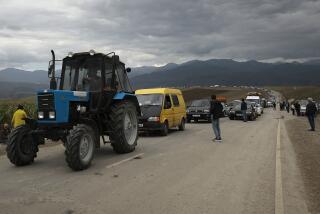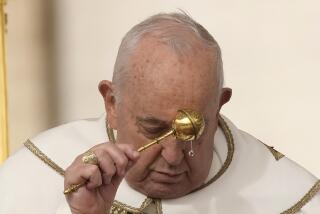Pope Addresses the Wounds of a Nation’s Greatest Loss
YEREVAN, Armenia — Pope John Paul II bowed before an eternal flame Wednesday to commemorate the mass slaughter of Armenians under Turkish imperial rule and led hushed, tearful descendants of the dead and the survivors in prayer for “a healing of still open wounds.”
“We are appalled by the terrible violence done to the Armenian people and dismayed that the world still knows such inhumanity,” the Roman Catholic leader said during a ceremony at Tsitsernagaberd, a suburban memorial to the victims.
Dozens of Armenians from this overwhelmingly Christian country and its diaspora gathered below the memorial’s needle-like obelisk and watched through wide spaces between 12 inward-leaning granite columns encircling the flame. A choir’s mournful singing and the wails of a few spectators punctuated the silence.
The deaths in the early 20th century are one of Armenia’s most painful memories and the reason for enduring estrangement from Turkey, its mostly Muslim neighbor. But in writing his prayer, the pope tried--with apparent success--to keep the passions stirred up here from spilling across the border.
An estimated 1.5 million Armenians were slaughtered in eastern Turkey between 1915 and 1923, during World War I and the subsequent collapse of the Ottoman Empire.
John Paul, who is appealing for Muslim-Christian peace after the Sept. 11 attacks on the United States, did not want his long-planned visit here to inflame the Turks, who have protested recent moves by European countries to recognize the 20th century deaths as genocide.
The risk of offense was high. Pope Benedict XV had defend the Armenians in a 1915 letter that John Paul brought to hang in the memorial’s museum. John Paul was on record calling the deaths genocide, even though he had not declared any party responsible.
On Wednesday, the polyglot pope skirted the controversy with linguistic sleight of hand.
“Listen, O Lord, to the lament that rises from this place, to the call of the dead from the depths of the Metz Yeghern,” he said, delivering his prayer in English except for the Armenian term for the event.
Metz Yeghern means both great crime and great evil in Armenian, although yeghern in some dictionaries also means genocide--a term that came into general use only after the Nazi effort to eliminate Jews during World War II.
“For the English-speaking public, ‘genocide’ would have been more explicit,” said the Rev. Jirair Sogomian of the Protestant Armenian Evangelical Church of Paramus, N.J., who attended the ceremony. “But then again, you can learn a couple of Armenian words.”
Karekin II, patriarch of the Armenian Apostolic Church, used those same Armenian words later Wednesday in voicing “heartfelt gratitude” to John Paul for honoring the victims. Neither Karekin nor the pope mentioned Turkey.
The Turkish government, which still denies culpability in the deaths, kept silent on Wednesday’s papal ceremony, and Turkish news media gave it only cursory coverage. One official said privately that, because the pope had avoided the word genocide, there was no cause for diplomatic protest.
“Still, in a way, the genocide has been recognized,” said Taline Abkarian, 36, a graphic designer from Encino, who is visiting Armenia with her parents and sister. Her grandparents fled during the violence and settled in Lebanon. “Now at least the souls and spirits of the victims can probably rest better.”
Other Armenians converged here from Argentina, Australia, Greece, Cyprus, Lebanon and elsewhere to take part in this week’s celebrations of the 1,700th anniversary of Christianity as this country’s state religion. The singer Charles Aznavour, a Frenchman of Armenian origin, sang at the memorial.
Wednesday, the penultimate day of a tiring six-day journey that took the pope first to Kazakhstan, he got through two speaking appearances. Bishop Stanislaw Dziwisz, his personal secretary, kept a supportive hand on the pope almost constantly, gripping John Paul’s waistband firmly from behind as they descended a flight of stairs toward the eternal flame.
When it was time to deposit a red rose on the flame’s stone perimeter, Dziwisz grasped the pope’s wrist and gently extended his arm so that the flower would fall in line with those left by other prelates instead of at his feet.
Later, John Paul led an ecumenical celebration at the nearly finished St. Gregory the Illuminator cathedral, named for the missionary who brought Christianity here and built with nearly $10 million from Armenians living abroad.
The pope called for restored communion between the Vatican and the Armenian Apostolic Church, which split in 506.
*
Times special correspondent Amberin Zaman in Ankara, Turkey, contributed to this report.
More to Read
Sign up for Essential California
The most important California stories and recommendations in your inbox every morning.
You may occasionally receive promotional content from the Los Angeles Times.










